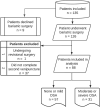Increased plasma ANGPTL7 levels with increased obstructive sleep apnea severity
- PMID: 36017324
- PMCID: PMC9396619
- DOI: 10.3389/fendo.2022.922425
Increased plasma ANGPTL7 levels with increased obstructive sleep apnea severity
Abstract
Background: Weight-loss surgery is one of the recommended methods for treating obstructive sleep apnea (OSA) in obese patients. While weight reduction is critical to relieve symptoms of OSA, the biochemical factors involved in post-surgery improvement are still unknown. We aimed to explore the link between ANGPTL7 and OSA in patients with different OSA severity. Furthermore, we examined the effect of treating OSA with bariatric surgery on ANGPTL7 level.
Methods: We quantified levels of circulating ANGPTL7 in fasting plasma and adipose tissue samples of 88 participants before and after bariatric surgery. Confocal microscopy analyses were also performed to assess the ANGPTL7 expression in subcutaneous white adipose tissue biopsies obtained from people with moderate-to-severe OSA compared to those with none or mild OSA. The study involved 57 individuals with none or mild OSA and 31 patients with moderate-to-severe OSA.
Results: Levels of circulating ANGPTL7 were significantly higher in people with moderate-to-severe OSA (1440 ± 1310 pg/ml) compared to the none or mild OSA group (734 ± 904 pg/ml, p = 0.01). The increase in ANGPTL7 correlated significantly and positively with the apnea-hypopnea index (AHI, r = .226, p = .037), and AHI-supine (r = .266, p = .019) in participants with moderate-to-severe OSA. Multivariate logistic regression analysis demonstrated an association between ANGPTL7 and OSA severity (log2 ANGPTL7; OR =1.24, p = 0.024). ANGPTL7 levels exhibited significant positive correlations with the levels of TG and oxLDL (p-value = 0.002 and 0.01 respectively). Bariatric surgery reduced the levels of both ANGPTL7 and AHI significantly.
Conclusion: Here we report significantly increased levels of ANGPTL7 both in the circulation and in adipose tissue of patients with OSA, which concurred with increased inflammation and OSA severity. Levels of ANGPTL7 decreased significantly as OSA showed a significant improvement post-surgery supporting a potential role for ANGPTL7 in either OSA progression or a role in an OSA-related mechanism.
Keywords: ANGPTL7; apnea hypopnea index; bariatric surgery; hypoxia; obstructive sleep apnea; polysomnography.
Copyright © 2022 Leentjens, Alterki, Abu-Farha, Bosschieter, de Raaff, de Vries, Al Shawaf, Thanaraj, Al-Khairi, Cherian, Channanath, Kavalakatt, van Wagensveld, de Vries and Abubaker.
Conflict of interest statement
NV is a member of the Medical Advisory Board of NightBalance, consultant of Philips Healthcare, Inspire Medical Systems and Nyxoah. The remaining authors declare that the research was conducted in the absence of any commercial or financial relationships that could be construed as a potential conflict of interest.
Figures






References
MeSH terms
Substances
LinkOut - more resources
Full Text Sources
Medical
Miscellaneous

